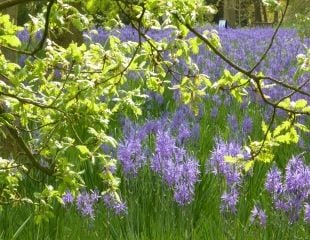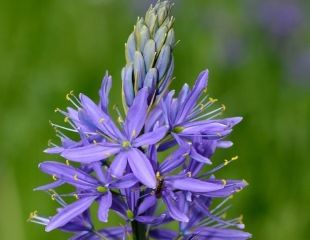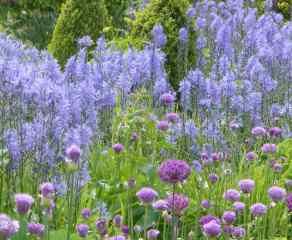


How to Grow Camassia
Camassia is a lovely spring flowering bulb in shades of soft blue and white and can be mistaken for bluebells. It's not commonly grown, but, with the right conditions, it makes an excellent and unusual spring-flowering bulb.
Camassia can flower anything from April, May and into early June, Camassia has large spikes of flowers in blue, purple or white. Commonly offered for sale are C. cusickii, quamash, (center image,) and Leichtlinii, (right image.) all of which are available from Crocus via this affiliate link. From a distance, when planted on mass, they can be mistaken for Bluebells,as shown in the image. These images were all taken at RHS Harlow Carr.
The flowers are lily like, with coloured stamens and open from the base upwards. Camassia grows to around 1-1.3m. North America is the origin of the bulbs, where they grow alongside streams and damp meadows. Given their natural growing conditions, it follows Camassia will tolerate damp conditions, dappled shade, and look ideal in a woodland setting, as illustrated in the images.
The leaves are slow to die down, similar to Alliums, and do not look ideal, especially after the flowers have faded.

Bearing in mind the flowering time in late April/ May, good planting companions are the early flowering Alliums, early flowering Geraniums and Aquilegia. To mask the faded leaves as they die back, Hosta would also be a good companion plant suitable choosing a variety which is for partial shade and moist conditions. Camassia also looks good combined with daffodils, again selecting a later flowering variety.
In common with many bulbs, leave the foliage in place as it dies back to feed and strengthen the bulb. For this reason, it is best to have companion planting to cover the leaves. By summer, when the leaves turn brown, you can then remove them.
Camassia looks good planted in semi wild setting such as in long grasses and with wildflowers.
Camassia is a less invasive alternative to Bluebells.
They make fabulous cut flowers.
Where and How to Plant Camassia
For the best results, pant Camassia in a sheltered spot, into moist, well drained soil, in sun or partial shade. Camassia will tolerate some wet, but not boggy conditions. Even though Camassia prefers damp conditions, because Camassia is a tough plant, they will usually survive a degree of summer drought. Grow Camassia in sun or partial shade; they are pest-free.
Camassia is tolerant of all soil types and will grow in Chalk, Loam, Sand and soil which is Acid, Alkaline, or Neutral.
Categorised as hardy H4, which is hardy in most of the UK -10-5, Camassia benefit from winter protection by a covering of mulch, at least for the first year to get them established and annually in colder areas or exposed areas, (although the Camassia in the images were growing at RHS Harlow Carr, which is Yorkshire so quite a cold area.)
Camassia dislikes being moved and root disturbance.
Plant Camassia bulbs in the autumn, at least 10cms deep (4") which is about 3 times the bulb's depth, and a similar distance apart into well-drained soil which does not become waterlogged. Water well after planting. They need no attention or maintenance after planting and are trouble free.
If you experience a lack of flowers, this may be because of the soil conditions being too dry. Camassia does like damp soil.

Camassia grows well without maintenance in the right conditions, predominantly damp soil.
